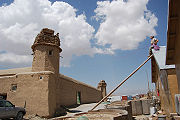
Qalat (fortress)
Encyclopedia

Persian language
Persian is an Iranian language within the Indo-Iranian branch of the Indo-European languages. It is primarily spoken in Iran, Afghanistan, Tajikistan and countries which historically came under Persian influence...
for 'fortified place.' It frequently occurs in place names. Qalats can range from castles like Rumkale to the mud-brick
Adobe
Adobe is a natural building material made from sand, clay, water, and some kind of fibrous or organic material , which the builders shape into bricks using frames and dry in the sun. Adobe buildings are similar to cob and mudbrick buildings. Adobe structures are extremely durable, and account for...
compound common throughout southwest Asia, particularly in tribal areas with pre-modern building practices.
In many areas of Iran, Afghanistan and Pakistan the qalat compound is the standard housing unit for multi-generational families. Qalats can be quickly constructed over the course of a single season, and they can be extremely large, sometimes covering several acres. Towers may be placed at the corners or points along the walls to create a more defensible position, but most qalat compounds consist only of the walls.
While the foundation of a qalat compound may be stone or fired brick, the walls are typically dried mud. Walls are created by laying down a row of adobe bricks with mud mortar along the entire length of the wall. By the time that the mason returns to the point of origin, the mortar is dry and the next row can be added on top of the old. Using this technique walls dozens of feet high can be built very rapidly.
Further reading
- Kennedy, Hugh N. (2006) Muslim Military Architecture in Greater Syria Brill, Leiden, ISBN 90-04-14713-6
- Facey, William (1997) Back to Earth: Adobe Building in Saudi Arabia Al-Turath in association with the London Centre of Arab Studies, London, ISBN 1-900404-13-3
- Bing, Judith et al. (1996) Architectural Elements of Traditional Settlements International Association for the Study of Traditional Environments, Berkeley, California, OCLC 37475487
- Szabo, Albert and Barfield, Thomas J. (1991) Afghanistan: An Atlas of Indigenous Domestic Architecture University of Texas Press, Austin, Texas, ISBN 0-292-70419-4
- Hallet, Stanley Ira and Samizay, Rafi (1980) Traditional Architecture of Afghanistan Garland STPM Press, New York, ISBN 0-8240-7059-3
- Mumtaz, Kamil Khan (1983) Traditional Forms of Rural Habitat in Pakistan UNESCO, Paris, OCLC 10606333

